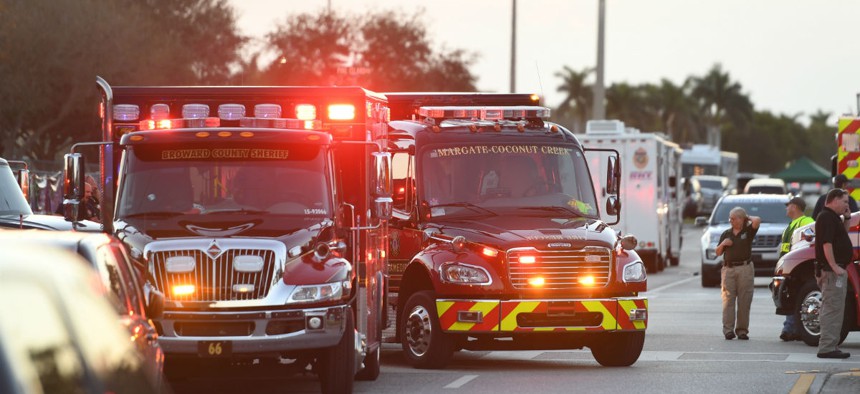
The scene outside Stoneman Douglas High School in Parkland, Fla., on Wednesday, following a mass shooting that killed 17 students and staff. MPI04 / MediaPunch/IPX
1990s Law Limits CDC's Ability to Research Gun Violence As a Public Health Issue
Law was intended to prevent gun control advocacy, but has ended up preventing the agency from studying gun-related deaths.
After a deadly shooting, the debate always, it seems, breaks down like this: One side argues for gun control, and the other argues there is no research proving those measures work. There is, in fact, little research into gun violence at all—especially compared to other causes of death in the United States.
The modern origins of the impasse can be traced to 1996, when Congress passed an amendment to a spending bill that forbade the Centers for Disease Control and Prevention from using money to “advocate or promote gun control.”
The National Rifle Association had pushed for the amendment, after public-health researchers produced a spate of studies suggesting that, for example, having a gun in the house increased risk of homicide and suicide. It deemed the research politically motivated. Gun-rights advocates zeroed in on statements like that of Mark Rosenberg, then the director of the CDC’s National Center for Injury Prevention and Control. In response to the early ’90s crime wave, Rosenberg had said in 1994, “We need to revolutionize the way we look at guns, like what we did with cigarettes ... It used to be that smoking was a glamour symbol—cool, sexy, macho. Now it is dirty, deadly—and banned.”
The actual amendment sponsored by Jay Dickey, a congressman from Arkansas, did not explicitly forbid research into gun-related deaths, just advocacy. But the Congress also lowered the CDC’s budget by the exact amount it spent on such research. Message received. It’s had a chilling effect on the entire field for decades.
Medical and public-health professionals have been pushing back—more and more forcefully in recent years. The American Public Health Association and the American Medical Association have both taken to calling gun violence a public-health problem. In 2016, more than 100 medical organizations signed a letter to Congress asking to lift the Dickey Amendment.
“We in public health count dead people. It’s one of the things we do. And we count them in order to understand how to prevent preventable deaths,” Nancy Krieger, an epidemiologist at the Harvard T.H. Chan School of Public Health, told NPR in 2015.
The CDC is best known for fighting diseases—it’s in the name—but its public-health purview is indeed wider. The agency studies drownings, accidental falls, traumatic brain injuries, car crashes, suicides, and more. And while mass shootings grab headlines, they account for only a small fraction of the 30,000 gun deaths a year in the United States. More than half are suicides. Yet the 1996 amendment has restricted how much the CDC can focus on gun ownership as the risk factor in suicides.
Researchers who do want to study gun violence have cobbled together funding from a patchwork of sources, often from private foundations. President Obama signed an executive order directing the National Institutes of Health to fund research into gun violence after the Sandy Hook shooting, but the program has since petered out.
The problem, researchers say, is also a lack of data. While motor-vehicle deaths are tracked in minute detail in the Fatality Analysis Reporting System, no such comparable database exists for gun deaths. Basic questions like exactly how many households own guns are not definitively answered.
Dickey, the congressman responsible for the amendment suppressing the CDC’s gun violence research, passed away last April. He had come to regret his role in the episode. In 2012, he coauthored a Washington Post op-ed with Rosenberg, the very CDC official he squared off against when passing the amendment. Together, they argued for more gun-violence research.
Dickey told reporters, “I wish I had not been so reactionary.”






